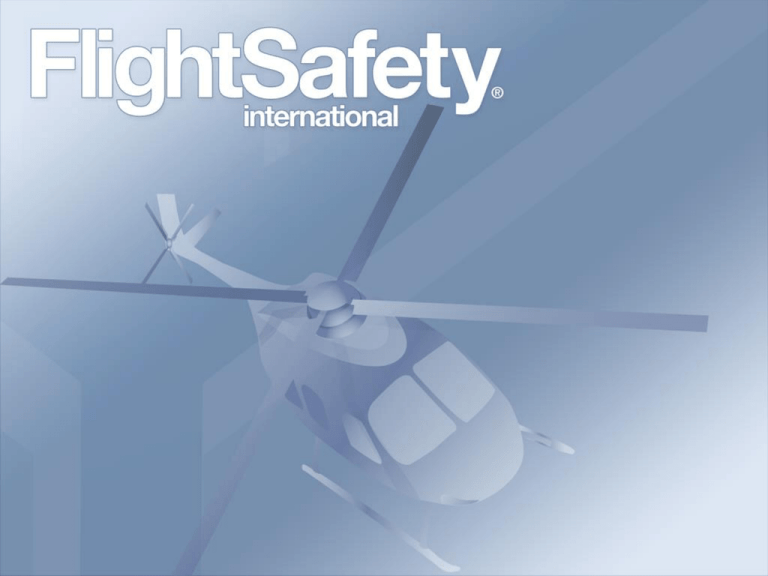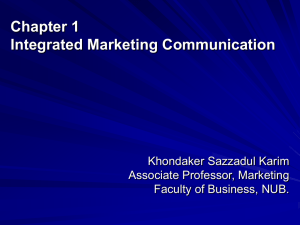IMC Tactics and Strategies
advertisement

HELICOPTER INADVERTENT IMC AVOIDANCE TACTICS AND STRATEGIES INADVERTENT IMC AVOIDANCE TACTICS AND STRATEGIES Pat A. Leone [mouse activated for each major bullet] 3 Copyright © 2008 FlightSafety International, Inc. Unauthorized reproduction or distribution is prohibited. 3 Introduction PAT A. LEONE, AAS, BBA, ATP, CFII (US) Rotorcraft/Helicopter • Director of Standards, DFW Learning Center, FlightSafety International (17 years) • 14000 + Hours • Military/Commercial/Corporate Aviation • 10+ Years Experience as an Army Safety Officer IMPORTANT INFORMATION 5 Copyright © 2008 FlightSafety International, Inc. Unauthorized reproduction or distribution is prohibited. 5 OVERVIEW 6 Copyright © 2008 FlightSafety International, Inc. Unauthorized reproduction or distribution is prohibited. 6 IIMC Avoidance Tactics and Strategies Overview • Helicopter IIMC Studies • Anatomy of an IIMC Accident (Why? How?) • Avoidance Tactics and Strategies • IIMC Recovery • A Glimpse of New Technologies 7 Copyright © 2008 FlightSafety International, Inc. Unauthorized reproduction or distribution is prohibited. 7 IIMC Accident Studies 8 Copyright © 2008 FlightSafety International, Inc. Unauthorized reproduction or distribution is prohibited. 8 Principal IIMC References 9 Source Title Understanding the Human Factors Associated With VFR Flight into IMC (Abbreviated) U.S. DOT/FAA Office of Understanding the Human Factors Aerospace Medicine Associated with VFR Flight into IMC May 2008 National Research Laboratories of the Netherlands (NLR) Helicopter Flight in a Degraded Visual Environment Dec 2013 International Helicopter Safety Team (IHST) Training Fact Sheet – Inadvertent Entry Into Instrument Meteorological Conditions (IIMC) UNK U.S. Helicopter Safety Team (USHST) Comparative Report, Vol. 2 (Comparing data CY2001,02,06 with CY2009-11) AUG 2014 Copyright © 2008 FlightSafety International, Inc. Unauthorized reproduction or distribution is prohibited. Date 9 Principal IIMC References 10 Source Title Understanding the Human Factors Associated With VFR Flight into IMC (Abbreviated) U.S. DOT/FAA Office of Understanding the Human Factors Aerospace Medicine Associated with VFR Flight into IMC May 2008 National Research Helicopter Flight in a Degraded Visual “Visual Flight RulesLaboratories (VFR) into Instrument Meteorological of the Netherlands (NLR) are a major Environment Conditions (IMC) accidents concern in the Dec 2013 aviation industry. More than of the fatal International Helicopter Safety70%Training Factweather-related Sheet – Inadvertent Entry accidents involved General Aviation (GA) pilots operating Team (IHST) Into Instrument Meteorological under visual flight rules (VFR) thatConditions continued (IIMC) into IMC.” “The results indicatedSafety that Team . . VFR—IMCComparative pilots were more likely U.S. Helicopter Report, Vol.to 2 (Comparing commit a perceptual error . .; (USHST) a decision error . .; experience data CY2001,02,06 with CY2009-11) and commit a violation . . than RoGA.” (the Rest of General Aviation) UNK Copyright © 2008 FlightSafety International, Inc. Unauthorized reproduction or distribution is prohibited. Date AUG 2014 10 Principal IIMC References 11 Source Title Understanding the Human Factors Associated With VFR Flight into IMC (Abbreviated) U.S. DOT/FAA Office of Understanding the Human Factors Aerospace Medicine Associated with VFR Flight into IMC May 2008 National Research Laboratories of the Netherlands (NLR) Helicopter Flight in a Degraded Visual Environment Dec 2013 International Helicopter Safety Team (IHST) Training Fact Sheet – Inadvertent Entry Into Instrument Meteorological Conditions (IIMC) UNK U.S. Helicopter Safety Team (USHST) Comparative Report, Vol. 2 (Comparing data CY2001,02,06 with CY2009-11) AUG 2014 Copyright © 2008 FlightSafety International, Inc. Unauthorized reproduction or distribution is prohibited. Date 11 Principal IIMC References 12 Source Title Understanding the Human Factors Associated With VFR Flight into IMC (Abbreviated) U.S. DOT/FAA Office of Understanding the Human Factors Aerospace Medicine Associated with VFR Flight into IMC May 2008 National Research Laboratories of the Netherlands (NLR) Helicopter Flight in a Degraded Visual Environment Dec 2013 International Helicopter Safety Team (IHST) Training Fact Sheet – Inadvertent Entry Into Instrument Meteorological Conditions (IIMC) UNK U.S. Helicopter Safety Team (USHST) Comparative Report, Vol. 2 (Comparing data CY2001,02,06 with CY2009-11) AUG 2014 Copyright © 2008 FlightSafety International, Inc. Unauthorized reproduction or distribution is prohibited. Date 12 INADVERTENT IMC Inadvertent IMC – What is it? Pat’s Definition: “Unplanned, Unexpected and Unintentional Entry into the Instrument Environment” Why Do IIMC Accidents Occur? Cause: Human or Meteorological? Why Do IIMC Accidents Occur? • • • • Mission? Management? Financial? Poor Decision Making? Why Do IIMC Accidents Occur? Or is it: PRES SURE ? Anatomy of an IIMC CFIT Accident Let’s take a ride in my BH 206: Mission: Pick up Boss to take him and family to airport for vacation WX: 00000 2KM BR OVC004 21 21 A2985 Anatomy of an IIMC CFIT Accident PLAN: Avoid IMC Anatomy of an IIMC CFIT Accident Weather – actually a little worse than forecast 5 Miles from airport – frequency change Anatomy of an IIMC CFIT Accident 180 Degree Turn/ Return to VMC • Pilot initiates the maneuver by moving the cyclic in the direction of turn (normally to pilot side) • Rotates head to scan outside of window in the direction of turn • Helicopter continues to roll near or fully inverted position • Helicopter loses altitude and impacts terrain Single Pilot IIMC Accident “The weather was terrible last night. But that's what we do. We call it pushing the weather.” [TYPEWRITER IN] Anatomy of an IIMC CFIT Accident Lesson Elements • • • • • Understanding the Body in Space Unplanned Entry into IMC – What Happens Natural Physiological Response Exit Tactics Failure/Success Modes • Humans Are VFR-Only: – Senses used to maintain balance are unreliable when bodies are in a “controlled gravity” situation – Visual reference overrides other senses’ input to the brain, providing constantly updated reality checks – Reliance on non visual sensory inputs can cause pilots deprived of visual references to quickly lose control of an aircraft – We will explore what happens 23 OVERVIEW 24 The Human Body • The Sensory Organs of the Body – Visual – Vestibular – Proprioceptive • The Psoas Muscle • Human Decision Making Under Stress • Strategies for Overcoming Their Effects 25 VISUAL SYSTEM Most reliable source of information: • – 90% of information used for point of reference comes through the eyes – Overrides conflicting sensations from other systems – Vision in VMC enables proper orientation to Earth by reference to the ground, sky and horizon – Pilots have a tendency to rely too much on outside visual references, ignoring what they can see in IIMC 26 VISUAL SYSTEM • Limitations: – Pilot is rarely aware brain receives conflicting signals from other systems – Vulnerable to sensory misinformation, causing errors in processing or interpreting – Succumbing to illusions can lead quickly to irreversible spatial disorientation 27 VESTIBULAR SYSTEM 28 VESTIBULAR SYSTEM •Semicircular Canals: PITCH – Three half-circular, interconnected tubes located in each ear – Equivalent of three gyroscopes located in three orthogonal planes – Canals are not perpendicular – Head movements stimulate horizontal and vertical canals simultaneously •Otolithic Organs: – Sense Linear Accelerations – Send Signals to eye and balance muscles 29 YAW ROLL SEMICIRCULAR CANALS VESTIBULAR SYSTEM • Linear accelerations stimulate otolith organs, because the resulting inertial forces cannot be distinguished physically from the force of gravity • Forward acceleration results in backward displacement of otolithic membrane, creating an illusion of backward tilt. • The system can establish an altered plane of reference • This is more commonly experienced during turns • Pilot must rely on instruments to prevent disorientation 30 PITCH YAW ROLL SEMICIRCULAR CANALS PROPRIOCEPTIVE SYSTEM 31 PROPRIOCEPTIVE SYSTEM • Composed of – Nerves in the • • • • Skin Muscles Joints Internal organs • Relatively unnoticed on the ground • Nerves sense pressure differentials when airborne • Pilots feel changes in Gforces and pressure as the body reacts to aircraft motion 32 PROPRIOCEPTIVE SYSTEM • Normally used as a back up to our visual system • Can be easily confused in flight • Any change in G-forces can mislead the pilot regarding aircraft attitude • Combination of semicircular canals, otolith, and proprioceptive signals in flight cause somatogyral illusions can occur 33 PROPRIOCEPTIVE SYSTEM Otoliths & Somatogyral illusions Semi-Circular Canals • Vestibular – Illusions of Orientation • Coriolis – “Tumbling of internal gyros” – Most dangerous • Leans – Pilot senses turn in straight and level flight, leaning in opposite direction • Oculogravic – Acceleration/ Deceleration in level flight causes otolith organs to sense a nose-high attitude relative to gravity • Rotational (Angular Motion) – Result from misinformation from a contant-rate turn 34 Proprioceptive Organs PSOAS MUSCLE 35 PSOAS MUSCLE 36 PSOAS MUSCLE • Large muscle that anchors your leg to your trunk, which Influences movement and rotation of the pelvis • All organs are in contact, either directly or indirectly with the diaphragm and psoas. • Functions to bend your hip and leg towards your chest • Psoas flexes the hip when the fear reflex is activated (as seen in a startled infant when legs move up toward its face to protect itself) • During stress times, in self protection mode, psoas is in constant state of contraction • Other natural self protection mechanisms cause the arms to move 37 up and over the head to provide protection Decision Making Under Stress 38 Decision Making Under Stress • Basic Brain Function in Thinking and Decision Making • Thalmus – receives organ sensory inputs (perceptions) via nerves and transmits information to the Cerebral Cortex • Cerebral Cortex – • Interprets, filters and assimilates information; • Discriminates between automatic and conscious responses • Limbic System – • Responsible for emotions, feelings, character traits and behavior • Provides input back to Thalmus, which then secretes neurohormones which stimulate the pituitary gland • Stress reaction begins 39 Decision Making Under Stress • Brain Function Under Great Stress • Process of thinking usually characterized by: • Loss of concentration • Inability to perceive new information (to learn) • Hampered short-term memory • Lack of initial planning of actions • Hasty decision making • Temporary damage of the hippocampus (responsible for learning and memory 40 Decision Making Under Stress • Brain Function Under Great Stress • Stress response obviously aimed at immediate physical reaction • Processes such as learning and planning not of primary concern • More important to react physically ASAP, rather than to react in the most appropriate way (which involves planning, which requires a loss of precious time 41 Anatomy of an IIMC CFIT Accident Sometimes, when a person has suffered extreme physical or psychological trauma (including massive stress), they will assume the fetal position or a similar position in which the back is curved forward, the legs are brought up as tightly against the abdomen as possible, the head is bowed as close to the abdomen as possible, and the arms are wrapped around the head to prevent further trauma. This position provides better protection to the brain and vital organs than simply lying spread out on the ground, so it is obvious as to why it is an instinctual reaction to extreme stress or trauma when the brain is no longer able to cope with the surrounding environment, and in essence “shuts down” temporarily. Anatomy of an IIMC CFIT Accident ILLUSTRATION SPATIAL DISORIENTATION 45 Human Factors Contributing to IIMC Accidents Skill-based Errors Personal Readiness Technological Environment Perceptual Errors Physical/ mental limitations Adverse physiological states Decision Errors Violations Adverse Mental States Crew Resource Management Human Factors Contributing to IIMC Accidents Skill-based Skill-based errors (occur with little or no conscious thought, ie: driving a car) – most Errors common GA error Decision Personal Decision Errors (misinterpretation common in IIMC CFIT Readiness or improper choices) – mostErrors accidents Perceptual errors (arise when sensory input is degraded) Violations (routine/habitual vs exceptional (to excess)) Technological Perceptual attitudes Adverse mental states (loss of SA, fatigue, circadian dysrhythmia, pernicious Environment Errors (overconfidence, complacency, misplaced motive)) Adverse physiological states (spatial disorientation, visual illusions, hypoxia, illness, intoxication) Physical/mental limitations (necessary sensory information isn’t available, or individuals Physical/ lack aptitude, skill, or time to safely deal with) Violations mental Crew resourcelimitations management (confusion, poor decision making, due to internal and external communications failures) Personal readiness: lack of crew rest, self medication, overall not ready for flight Adverse Technological environment (TE): equipment/control design, display/interface Adverse physiological characteristics, checklist design, automation Mental States states Crew Resource Management AVOIDANCE STRATEGIES AND TACTICS The Art of Avoiding IIMC Session Elements SMS – Safety Management Systems Tactical Considerations SMS Overview • What is it? – Per AC 120-92: “a quality management approach to controlling risk.” • Benefits: – – – – – Promotes a sound safety culture Involves management Identifies threats and hazards proactively Provides opportunities to control risks effectively Considers both severity of consequences and likelihood of occurrence SMS • Safety Culture – – Essential human component of an organization – Reflects the organization’s values, beliefs, legends, rituals, mission goals, performance measures, and sense of responsibility to its employees, customers, and the community – Consists of psychological, behavioral, and organizational elements • Organizational elements most under management control • Other two elements are outcomes of management efforts SMS • Management Role – Top management primarily responsible for safety management – Managers plan, organize, direct, control activities – Allocation of Resources to insure effective controls – Must clearly delineate safety responsibilities – Empower organizational members • Organizational Members – Must know their responsibilities – Must be involved SMS • Safety Risk Management – Used to examine operational functions of the organization and operational environment – Identify hazards – Analyze associated risk – Focuses on areas of greatest risk from a safety perspective – Takes into account complexity, operational scope, etc. SMS Excerpt from AC 120-92A, Figure 2 SMS \\prt12N\FILE_SHARE\SCAN Tactical Considerations Tactical Considerations • PREFLIGHT PLANNING – Self Assessment – Crew Composition and Assessment – Helicopter Configuration and Capabilities – Route Planning/ Reconnaissance – Flight Considerations • Weather • Terrain and obstacles • ATC facilities – Instrument approach planning – Call Home!! Tactical Considerations • PREFLIGHT PLANNING – Self Assessment • Instrument Training & Experience – – – – Depth and Breadth (When? Where? Conditions?) Total Time vs Recency Proficiency vs Currency Having an Instrument Certificate May Mean Nothing • IMSAFE – Crew Composition, Capabilities, Limitations • Single Pilot • Single Pilot with Operator/Medic/Passenger(s) • Two Pilots (Assess Crew Capability) Tactical Considerations • PREFLIGHT PLANNING – Helicopter Configuration and Capability • • • • • No Flight Instruments? Basic Flight Instruments? AFCS? FD? Cockpit Set Up – Flight Considerations • Weather • Terrain and Obstacles (Hazards Planning) • Airport/Instrument Approach/ATC Facilities PREFLIGHT PLANNING • Weather Briefing – Formal • • • • Weather Services (Commercial/Government) Computer imagery Forecasts/SIGMETS/AIRMETS Know/Learn How to Use Them (Temp vs Dew Point) – Informal • Local Weather Lore • Contacts at the Destination PREFLIGHT PLANNING • Weather Minimums: – Regulatory – SOP – Personal – STICK TO THEM! PREFLIGHT PLANNING • Terrain and obstacle planning: – Evaluate terrain in relationship to the weather – Look for routes that will provide the best weather – Determine where the high terrain and obstacles are along your intended route of flight – Look for alternate routes – Evaluate aircraft climb performance in relation to the terrain PREFLIGHT PLANNING • ATC facilities: – Determine the ATC facilities along the route of flight – Know their frequencies and hours of operation – Understand what services they can provide you PREFLIGHT PLANNING • Airport/Instrument approach planning: – Determine available airports in the vicinity – Check available approach procedures – Determine compatibility with onboard navigation devices – Have current approach plates available - Check NOTAMS PREFLIGHT PLANNING • Aircraft configuration: – Is the aircraft certified for flight in IMC conditions – Are all flight instruments in a working condition – Are communication and navigation radios functional – Will there be enough fuel on the aircraft to allow for IMC operations PREFLIGHT PLANNING • Cockpit Setup: – Seating position set for instrument flying – Communication and navigation radios set for a quick transition to IMC flight – Approach charts readily available PREFLIGHT PLANNING CALL HOME!!! PREFLIGHT PLANNING If the choice is to fly, HAVE A PLAN!!! PREFLIGHT PLANNING • Error Planning Vs Success Planning • Single Plan (Avoid Weather) • Single Plan with Backup • Plan for Success • What to do if IIMC Occurs? PREFLIGHT PLANNING EVERY HELICOPTER PILOT NEEDS TO HAVE AN IIMC RECOVERY/SURVIVAL PLAN!!!! Joel S. Harris DURING FLIGHT DURING FLIGHT IN-FLIGHT OPERATIONS • Weather updates • Airspeed and altitude considerations • Remain in VMC conditions • Use low weather routes • Maintain contact with ATC facilities if possible • Abort or diversion considerations – Stop – Turn around – Use planned alternate route • Always maintain situational awareness IN-FLIGHT OPERATIONS • Weather updates: – Make contact with en-route weather reporting facilities to ensure you know the most current weather conditions – Monitor ATIS and AWOS facilities along the route of flight IN-FLIGHT OPERATIONS • Airspeed and altitude: – Do not fly faster than you can see. – Adjust altitude to avoid weather but maintain enough altitude for safe maneuvering IN-FLIGHT OPERATIONS • Aircraft configuration: – Operate the aircraft in the most stable mode available (attitude retention vs. SCAS/Force Trim/Friction) – Have flight director functions tested and set when available – If equipped, Have FMS/Nav /Comm Radios set/tuned for immediate recovery IN-FLIGHT OPERATIONS • Remaining in VMC conditions: – Adjust speed to allow for reaction time – Ensure you have visual references along your desired flight path. – Be very aware of deteriorating conditions IN-FLIGHT OPERATIONS • Low weather routes: – Attempt to use low weather routes instead of going direct – Try to determine several route options that will allow for safe completion of the flight – Consider the usefulness of a route during night operations IN-FLIGHT OPERATIONS • Communications: – Establish and maintain contact with the nearest available ATC facility (or local control/admin) – Relate/update your intentions – Request weather and traffic advisories – Stick to your Abort/Turn Around Plan IN FLIGHT OPERATIONS Abort or diversion considerations: – Signs of deteriorating weather conditions – Make the abort or diversion decision prior to getting into weather that may force you to go IMC – Use a preplanned diversion that most likely will allow you to successfully complete the flight – If IFR equipped and proficient - transition to IFR using a preplanned transition plan INADVERTENT IMC RECOVERY INADVERTENT IMC RECOVERY • Is it possible? • How would you define success? • How would you prepare yourself to achieve that success? IIMC Recovery Lesson Elements • Know Yourself • Know Your Equipment • Know Your Environment • Commit to the Instruments • Have a Plan/Execute the Plan • Multi Pilot Considerations • Hands On/Hands Off Considerations • U.S. Army Strategy: Emergency IMC Recovery Plan • Train for success Successful Recovery From an Inadvertent IMC Event • Know yourself • Instrument Proficiency Assessment • • Know Your Equipment • Stabilization equipment • Available, functioning? • Do you know how to use it? • Capabilities/limitations? • No stabilization? Force Trim? Try Friction Successful Recovery From an Inadvertent IMC Event • Know Your Equipment • Stabilization equipment • Available, functioning? • Capabilities/limitations? • Relationship between speed/altitude hold and power settings • Do you know how to use it? • Are you comfortable using it (trust)? • No stabilization? • Force Trim • Friction Controls Successful Recovery From an Inadvertent IMC Event • If you are not instrument proficient - FREEZE • Don’t move anything • Move only one control at a time, and by a very little bit • Adjust other controls, one at a time Successful Recovery From an Inadvertent IMC Event • Commit to the instruments • You are no longer flying – you are playing a video game • Scan • Don’t become fixated – keep your eyes moving • Don’t try to fix one thing completely – just get it moving in the right direction Successful Recovery From an Inadvertent IMC Event • Have a Plan/Execute the Plan • Know where you are • Know where the obstacles are and prioritize them • Use pre-planned escape routes • Do not turn unless it is required to avoid known obstacles or terrain • A bad plan may be much better than no plan at all (example) Successful Recovery From an Inadvertent IMC Event • Multi Pilot Considerations • Brief IIMC plan • Flying pilot remains on instruments • Non flying pilot divides attention inside and outside • Non flying pilot coaches flying pilot • Hands On/Hands Off Considerations • Military Strategy: Emergency IMC Recovery Plan • Train for success Successful Recovery From an Inadvertent IMC Event Train, Train, Train Successful Recovery From an Inadvertent IMC Event Why is Training Important? Successful Recovery From an Inadvertent IMC Event • Training • • • • • Overcomes Natural Effects of Extreme Stress Enhances Confidence Improves the Likelihood of Success Provides a Proven Path to Recovery Saves Lives! Successful Recovery From an Inadvertent IMC Event • Effective Training • Replicates Real Life Events and Circumstances • Presents High Risk Tasks in a Managed Risk Environment • Is Purposeful Successful Recovery From an Inadvertent IMC Event • Where To train: • Formally – School or Certified Instructor • • • • • • Best Structured Allows for Supervision/Objective Evaluation Provides Known/Established Standard Provides Rating Drawbacks • • Availability Expensive Successful Recovery From an Inadvertent IMC Event • Where To train: • Informally - On Your Own • • • • • Requires Commitment Avoids Large Expenditures More Flexible Can Occur in Your Environment Best With your Equipment Successful Recovery From an Inadvertent IMC Event • Where To train: • Company Sponsored Program • • • • • • • Controlled Internally Balances Expense and Availability May Lead to Additional Rating Demonstrates Company Commitment to Quality Instrument Training Environmentally Specific Equipment Specific Structure Based Successful Recovery From an Inadvertent IMC Event • How To train On Your Own: • Train to the Standard (Practical Test Standard) • With your Equipment • When Possible, Use Synthetic Flight Training Devices • Establish Training Schedule & Stick With It! Successful Recovery From an Inadvertent IMC Event • Entering into the IMC Environment • Commit to the Instruments • • Most Important Required Under All Circumstances • Execute the Plan • • Avoids Panic Response Better Assures Recovery Successful Recovery From an Inadvertent IMC Event • Scan • Don’t become fixated – keep your eyes moving • Don’t try to fix one thing completely – just get it moving in the right direction • Commit to the Instruments • Have a Plan/Execute the Plan • Single/Multi Crew Considerations • Hands On/Hands Off Considerations • Military Strategy: Emergency IMC Recovery Plan • Train for success FINALLY – Execute the Plan!!! • Divert • Climb • Stop • Abort • Recover EMERGING TECHNOLOGIES – GPWS (Ground Proximity Warning System) – EGPWS (Enhanced Ground Proximity Warning System –HTAWS (Helicopter Terrain Avoidance Warning Systems) –Visual Attitude Recovery Systems LESSON SUMMARY – In this time we have discussed: • Helicopter IIMC Studies • Anatomy of an IIMC Accident (Why? How?) • Avoidance Tactics and Strategies • IIMC Recovery • A Glimpse of New Technologies CONCLUSION We have discussed conditions that could lead to spatial disorientation and solutions to some of the problems that arise. 109 Questions? 110 FINALLY – ALWAYS REMEMBER: CALL HOME!!! 111 112 Copyright © 2008 FlightSafety International, Inc. Unauthorized reproduction or distribution is prohibited.









